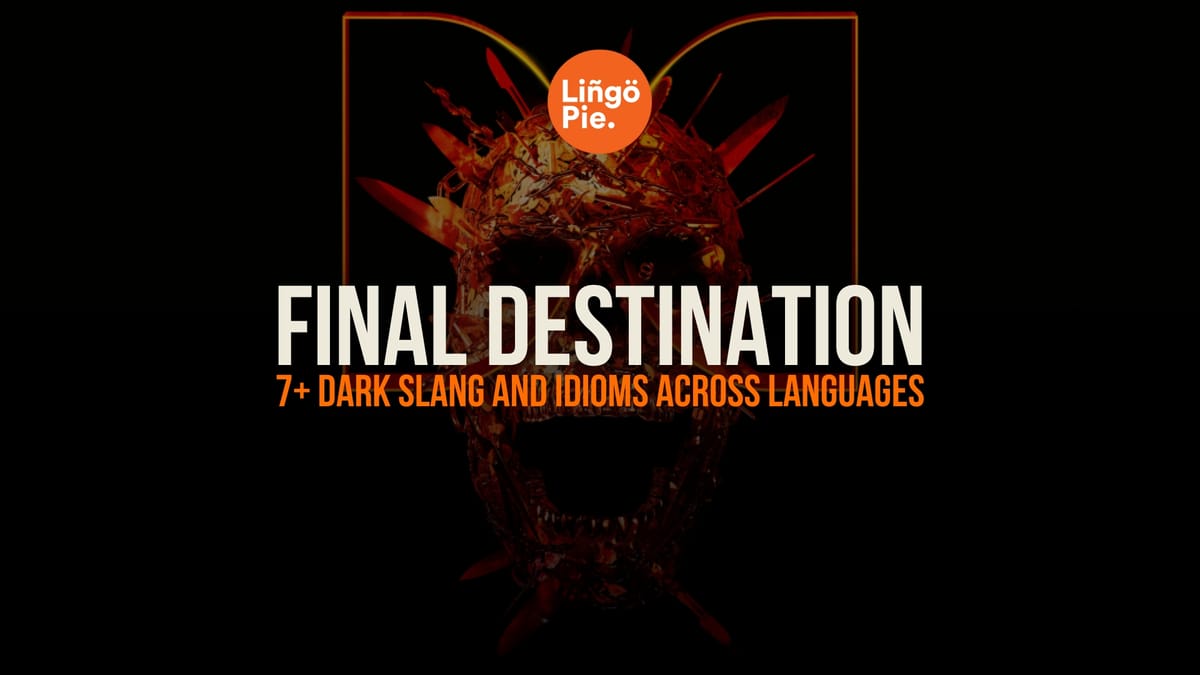Death is universal, but how we talk about it? That's where culture gets fascinating. With the release of Final Destination: Bloodlines bringing death back to the big screen, there's no better time to explore how different languages express the darker side of life.
Whether you're a horror fan or language enthusiast, these expressions offer a unique window into cultural attitudes toward mortality—and they might just make your language learning journey a little more exciting.
- Language Difficulty Ranking For English Speakers
- 60+ Surprising Italian Words Used In English
- Hardest Words In Spanish: 14 Pronunciation Nightmares (And How to Survive Them)

What Is Final Destination: Bloodlines?
Final Destination: Bloodlines is the latest installment in the iconic horror franchise where characters try to cheat death, only to have it hunt them down in increasingly creative ways. This 2025 release continues the tradition of psychological horror mixed with visceral death scenes, following new characters as they discover that escaping your fate is never as simple as it seems.
While the previous films focused on premonitions of disasters like plane crashes and highway pileups, Bloodlines introduces a new twist where death's design appears to follow family lines, creating an even more personal sense of dread for its characters.
The film follows college student Stefani Reyes, who inherits premonitions about a deadly tower collapse in 1968 from her dying grandmother. As Death comes for the Reyes family following a specific age order, Stefani desperately searches for a way to break the cycle and save her loved ones from their grisly fates.
Deathly Idioms In Foreign Languages
Idioms are expressions where the words together mean something different than their literal translation—and every language has plenty about death. Learning these phrases doesn't just build vocabulary; it offers cultural insights into how different societies process mortality.
German: "Den Löffel abgeben"
Literally meaning "to hand over the spoon," this German idiom is the equivalent of "to kick the bucket." The expression likely originated from medieval times when a dying person would have their spoon taken away as they no longer needed to eat.
Japanese: "あの世に行く" (Ano yo ni iku)
This phrase translates to "going to that world" and is a gentler way to refer to death in Japanese. The expression reflects the Buddhist influence in Japanese culture, where death is seen as a transition to another realm rather than an ending. It's commonly used in both casual conversation and more formal settings as a respectful way to refer to someone's passing.
French: "Manger les pissenlits par la racine"
The French idiom "to eat dandelions by the root" is a colorful way to say someone has died and is now buried. This expression vividly illustrates the perspective of the deceased, now underground where the roots are, adding a touch of morbid humor that's characteristic of French wit. It's similar in tone to the English phrase "pushing up daisies," but with a distinctly French botanical focus.
Spanish: "Estirar la pata"
In Spanish, "stretching the leg" is a common idiom for dying. The expression likely comes from the observation that when animals die, their legs often stiffen and stretch out. Despite its somewhat visual origin, it's used quite casually in Spanish-speaking countries, often with a tone that's more matter-of-fact than morbid.
Russian: "Отбросить коньки" (Otbrosit konki)
This Russian phrase literally means "to throw away one's skates" and is used to talk about death in a somewhat lighthearted way. The origin likely comes from the idea of no longer needing one's ice skates (a common item in Russian culture) after death. Like many Russian expressions, it manages to address a serious topic with a touch of dark humor.
Portuguese: “Bater as botas”
This Brazilian Portuguese idiom literally means “to hit the boots,” and is the rough equivalent of “kick the bucket” in English. It likely originated from military slang or the image of someone collapsing boots-first. Today, it’s commonly used in informal settings and even shows up in Brazilian memes and music lyrics. In Portuguese, humor is often used to cope with dark topics, and slang expressions about death are common in daily speech. This reflects Brazil’s cultural tendency to lighten even the heaviest of subjects through language and storytelling.
Korean: “돌아가시다” (doragashida)
Literally meaning “to return,” this is a formal and respectful Korean verb used to refer to someone’s death, especially elders or those of higher status. In Korean, there’s a strong line between respectful and disrespectful expressions, due to Confucian hierarchy and the importance of reverence for the dead. Using “죽다” (to die) for someone elderly can be seen as rude—“돌아가시다” is the respectful choice.

Dark Slang in Foreign Languages
While idioms are established expressions, slang evolves faster and often reflects contemporary attitudes—especially when it comes to taboo topics like death. Learning slang helps you understand natural, everyday conversations and connect with native speakers on a more authentic level.
German: "Abkratzen"
This German slang term literally means "to scrape off" but is used as a crude way to refer to dying. It's particularly common among younger generations and in casual settings, carrying a tone similar to "croaking" or "biting it" in English. The term's harshness makes it inappropriate for formal situations, but understanding it helps you navigate German TV shows and casual conversations.
Japanese: "くたばる" (Kutabaru)
This is a rough, slang way to say "drop dead" or "die" in Japanese. It's considered quite vulgar and should never be used in polite company or formal settings. The term appears frequently in manga, Japanese anime, and films where characters are expressing extreme anger or in stories featuring yakuza or other criminal elements.
French: "Casser sa pipe"
The French slang "to break one's pipe" is a common way to refer to death, similar to "kick the bucket" in English. The expression possibly originated from World War I, where soldiers' clay pipes would break when they fell in battle. Despite its somewhat grim origin, it's used quite casually in modern French and appears regularly in films and literature.
Spanish: "Palmar"
This Spanish slang term for dying is derived from "palma" (palm), possibly referencing the biblical tradition of palm branches at funerals. It's widely used throughout Spanish-speaking countries, especially in casual conversation and media like films and television. The term carries a tone similar to "to croak" in English—not particularly polite, but not the most offensive option either.
Mexican Spanish: "Petatearse"
In Mexican Spanish, this colorful slang term for dying comes from "petate," a traditional woven mat that was historically used to wrap bodies before burial. The expression shows how slang often preserves cultural practices long after they've faded from common use. It's frequently heard in Mexican films and television, particularly those depicting rural or traditional settings.
Portuguese: “Esticar as canelas”
This Portuguese slang translates to “stretch the shins” and is used colloquially to mean someone has died. Similar in vibe to “estirar a pata,” it’s often used with a dark sense of humor in casual settings.
Korean: “골로 가다” (gollo gada)
This Korean slang expression literally means “to go to the goal,” but is a casual and dark-humored way to say someone has died or is doomed. It’s often heard in crime dramas, thrillers, and among young people.
- 6 Best Spanish True Crime Documentaries On Netflix
- 12 Korean Horror Movies You Need To Watch This Year
- 5 German Reality Shows On Netflix To Binge Today
Learning Languages Through Dark Content
Horror films like Final Destination: Bloodlines actually offer a unique opportunity for language learners. The high-stakes emotional content makes dialogue memorable, while universal themes of fear and survival connect across cultural boundaries.
Basically, learning through emotionally charged content like horror helps vocabulary stick in your memory more effectively. When your brain associates words with strong emotions (even fear!), you're more likely to remember them long-term. Horror films also tend to use a mix of everyday language and specialized vocabulary, giving you exposure to both practical phrases and expressions you might not encounter in traditional learning materials.
Connect Through Entertainment With Lingopie
With the release of Final Destination: Bloodlines sparking interest in how different cultures express mortality, now's the perfect time to turn your horror fascination into language learning. Lingopie makes this easy by offering interactive dual subtitles, vocabulary saving, and contextual learning—all while you enjoy content you'd watch anyway!
With a FREE 7-day trial account, you can start exploring horror classics in your target language on Lingopie. The platform's unique features let you click on those deathly idioms and dark slang terms to see definitions without pausing the action. Save them to your personal vocabulary list with a single click, and review them later through the app's spaced repetition system.
Ready to give it a try? Sign up for Lingopie today and discover how much faster you learn when death-defying content keeps you on the edge of your seat.
FAQ: Final Destination & Language Learning
What is the scariest death in the Final Destination series?
Many fans consider the roller coaster accident in Final Destination 3 the most terrifying—a perfect scene for learning fear-related vocabulary like "premonición mortal" (deadly premonition) in Spanish or "Todesangst" (death anxiety) in German. The logging truck sequence from Final Destination 2 teaches expressions like "échapper de justesse" (narrow escape) in French through its chain reaction of vehicular carnage.
Why are horror films like Final Destination particularly effective for language learning?
Horror films create strong emotional responses that significantly improve vocabulary retention, as fear and tension form stronger neural connections to new words than typical studying. The predictable structure of Final Destination (premonition, discussion, death scene) provides multiple contexts to hear the same vocabulary, reinforcing learning through repetition with emotional impact.
How can I practice the death idioms I learn from horror films?
Use Lingopie's interactive features to save unfamiliar expressions as you encounter them and review them later with flashcards. Try describing memorable death scenes from the films in your target language to practice using these expressions in context. Join language exchange groups where you can discuss horror films, giving you practical opportunities to use these culturally-specific expressions with native speakers.









